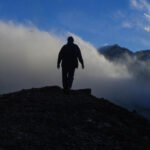I was camping in the Drumheller area last week (actually, we were closer to Hanna “home of Nickleback” Alberta). We had been there for a couple of days and I was taking the dogs for an evening run around the lake (actually a cooling pond for the nearby Sheerness Power Plant), when suddenly, the dogs darted into the brush next to the trail, pulling me (once again) off my bike.
The next moment, they came out of the bush, clawing at their mouths. For a moment, I thought they had caught something and were trying to consume it. Instead, it turns out they had both got a mouthful of porcupine quills.
In order to get the quills out, we had to drive to the animal hospital in Red Deer. Five hours and $500 later, we got back to the campsite as the sun was rising.
All this is to say encounters with wildlife can happen at anytime and anywhere, and around Tumbler Ridge, there are worse things than porcupine to startle.
Consider the story Fiona Orteza recently posted on Facebook: “My spouse and I just took our one-year-old and went on a quick hike to Flatbed Falls. We spent 30 minutes there, and then trekked back. On our walk back to the parking lot, we came within 15 feet of a mama black bear and two cubs.”
The bear seemed unconcerned to see the humans. “We had to wait about five minutes, watching and talking. The babies were watching us but luckily, the mama didn’t care too much about us. They lay down about 10 feet off the side of the trail, and we slowly walked up the trail talking and watching. They stayed put as we reached the top of the trail by the little blue gate. We walked backwards making sure they didn’t follow. We made it to our car safe and sound and the didn’t follow us.”
For some, avoiding bears means avoiding the wilderness. Others come armed with firearms to defend themselves.
For Orteza, having bear spray with her and easily accessible was the appropriate response.
“Thankfully, we always carry bear spray, within quick grabbing reach in a side pouch, and pulled it out just in case,” says Orteza. “Just wanted to remind everyone hiking PLEASE carry bear spray within quick grabbing reach and know how to use it. You never know what can happen!”
This encounter, like most bear encounters around Tumbler Ridge, ended without incident. And knowing how to move in bear country is a skill that anyone who plans to spend time outside should have.
Here are some simple precautions you can take to avoid dangerous bear encounters.
- Never feed or approach bears or other wildlife.
- Use caution in areas with high-quality food sources such as ripe berries and if you find a carcass or see scavengers, leave the area immediately.
- Surprising a bear can be very dangerous, so consider whether you are travelling up or down wind and if there is running water or heavy rain that can mask your sound.
- Make noise with your voice and clap your hands.
- Travel in groups when possible and always keep pets under control or on a leash.
- Mountain bikers are at risk of a high speed collision with a bear as trails are often good quality berry-producing habitat and bikers travel relatively silently at a high speed. When mountain biking make sure to slow down around blind corners and call ahead. Whatever your outdoor pursuit, if you do see signs of bear activity or hear noises, make sure your bear spray is readily accessible and leave the area if at all possible.
- Always check ahead for bears in the distance. If one is spotted, make a wide detour and leave the area immediately.
- Make warning noises and loud sounds.
- Watch for bear sign: tracks, droppings, overturned rocks, rotten trees torn apart, clawed, bitten or rubbed trees, bear trails, fresh diggings or trampled vegetation.
- Bears are as fast as racehorses, on the flats, uphill or downhill.
- Bears are strong swimmers.
- Bears have good eyesight, good hearing, and an acute sense of smell.
- All black bears and young grizzlies are agile tree climbers; mature grizzlies are poor climbers, but they have a reach up to 4 metres.
- If a bear is standing up it is usually trying to identify you. Talk softly so it knows what you are. Move away, keeping it in view. Do not make direct eye contact.
Above photo: from the archives, bear by the Co-op station a few years back
Trent is the publisher of Tumbler RidgeLines.

